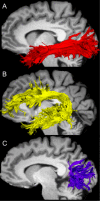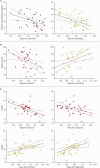"Can touch this": Cross-modal shape categorization performance is associated with microstructural characteristics of white matter association pathways
- PMID: 27696592
- PMCID: PMC6867048
- DOI: 10.1002/hbm.23422
"Can touch this": Cross-modal shape categorization performance is associated with microstructural characteristics of white matter association pathways
Abstract
Previous studies on visuo-haptic shape processing provide evidence that visually learned shape information can transfer to the haptic domain. In particular, recent neuroimaging studies have shown that visually learned novel objects that were haptically tested recruited parts of the ventral pathway from early visual cortex to the temporal lobe. Interestingly, in such tasks considerable individual variation in cross-modal transfer performance was observed. Here, we investigate whether this individual variation may be reflected in microstructural characteristics of white-matter (WM) pathways. We first trained participants on a fine-grained categorization task of novel shapes in the visual domain, followed by a haptic categorization test. We then correlated visual training-performance and haptic test-performance, as well as performance on a symbol-coding task requiring visuo-motor dexterity with microstructural properties of WM bundles potentially involved in visuo-haptic processing (the inferior longitudinal fasciculus [ILF], the fronto-temporal part of the superior longitudinal fasciculus [SLFft ] and the vertical occipital fasciculus [VOF]). Behavioral results showed that haptic categorization performance was good on average but exhibited large inter-individual variability. Haptic performance also was correlated with performance in the symbol-coding task. WM analyses showed that fast visual learners exhibited higher fractional anisotropy (FA) in left SLFft and left VOF. Importantly, haptic test-performance (and symbol-coding performance) correlated with FA in ILF and with axial diffusivity in SLFft . These findings provide clear evidence that individual variation in visuo-haptic performance can be linked to microstructural characteristics of WM pathways. Hum Brain Mapp 38:842-854, 2017. © 2016 Wiley Periodicals, Inc.
Keywords: DTI; haptics; individual variability; multisensory processing; shape processing; tractography.
© 2016 Wiley Periodicals, Inc.
Figures






Similar articles
-
Neuroanatomical correlates of haptic object processing: combined evidence from tractography and functional neuroimaging.Brain Struct Funct. 2018 Mar;223(2):619-633. doi: 10.1007/s00429-017-1510-3. Epub 2017 Sep 13. Brain Struct Funct. 2018. PMID: 28905126
-
Visual and Haptic Shape Processing in the Human Brain: Unisensory Processing, Multisensory Convergence, and Top-Down Influences.Cereb Cortex. 2016 Aug;26(8):3402-3412. doi: 10.1093/cercor/bhv170. Epub 2015 Jul 28. Cereb Cortex. 2016. PMID: 26223258
-
Enhanced visuo-haptic integration for the non-dominant hand.Brain Res. 2015 Jul 21;1614:75-85. doi: 10.1016/j.brainres.2015.04.020. Epub 2015 Apr 22. Brain Res. 2015. PMID: 25911582
-
Multisensory object representation: insights from studies of vision and touch.Prog Brain Res. 2011;191:165-76. doi: 10.1016/B978-0-444-53752-2.00006-0. Prog Brain Res. 2011. PMID: 21741551 Review.
-
A putative model of multisensory object representation.Brain Topogr. 2009 May;21(3-4):269-74. doi: 10.1007/s10548-009-0087-4. Epub 2009 Mar 28. Brain Topogr. 2009. PMID: 19330441 Free PMC article. Review.
Cited by
-
Audiovisual structural connectivity in musicians and non-musicians: a cortical thickness and diffusion tensor imaging study.Sci Rep. 2021 Feb 22;11(1):4324. doi: 10.1038/s41598-021-83135-x. Sci Rep. 2021. PMID: 33619288 Free PMC article.
-
Mental Rotation of Digitally-Rendered Haptic Objects.Front Integr Neurosci. 2019 Mar 14;13:7. doi: 10.3389/fnint.2019.00007. eCollection 2019. Front Integr Neurosci. 2019. PMID: 30930756 Free PMC article.
-
Distinct but related abilities for visual and haptic object recognition.Psychon Bull Rev. 2024 Oct;31(5):2148-2159. doi: 10.3758/s13423-024-02471-x. Epub 2024 Feb 21. Psychon Bull Rev. 2024. PMID: 38381302
-
Functional Anatomy of the Inferior Longitudinal Fasciculus: From Historical Reports to Current Hypotheses.Front Neuroanat. 2018 Sep 19;12:77. doi: 10.3389/fnana.2018.00077. eCollection 2018. Front Neuroanat. 2018. PMID: 30283306 Free PMC article. Review.
-
Comparative neuroanatomy: Integrating classic and modern methods to understand association fibers connecting dorsal and ventral visual cortex.Neurosci Res. 2019 Sep;146:1-12. doi: 10.1016/j.neures.2018.10.011. Epub 2018 Oct 30. Neurosci Res. 2019. PMID: 30389574 Free PMC article. Review.
References
-
- Amedi A, Malach R, Hendler T, Peled S, Zohary E (2001): Visuo‐haptic object‐related activation in the ventral visual pathway. Nat Neurosci 4:324–330. - PubMed
-
- Beaulieu C (2002): The basis of anisotropic water diffusion in the nervous system—A technical review. NMR Biomed 15:435–455. - PubMed
-
- Beaulieu C, Allen PS (1994): Determinants of anisotropic water diffusion in nerves. Magn Reson Med 31:394–400. - PubMed
Publication types
MeSH terms
LinkOut - more resources
Full Text Sources
Other Literature Sources

